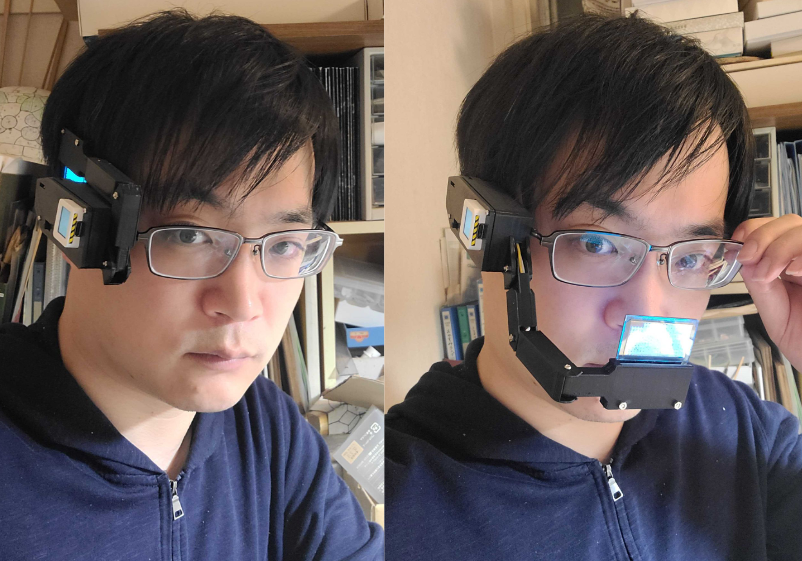About me

Personal Profile
GAKUTO SASABE was born in Japan, in 1992. He received the B.E. degree in electrical and electronic engineering.from the Tokyo University of Agriculture and Technology, and the M.E. degreein information technology from the Tokyo Institute of Technology, Tokyo, Japan, in 2018, un‑ der the supervision of Prof. Yasuhiro Miyake. After working on the development of the delivery of the Auto dish‑serving system as a Robotics Technician, he is currently involved in the development of semiconductor manufacturing equipment as a Software Engineer. He is interested in augmenting human capabilities using technologies such as AR, VR and electrical engineering, as well as insights from cognitive psychology and human‑computer interaction.
Interests
Reserch
Human Augmentation, Human Computer Interaction ,cognitive phycology,ghost engineering, Embodied cognition, AR/VR/MR
Maker
On weekends, he gathers with company volunteers and engages in maker activities, including the creation of body augmentation devices. They also participate in Makers Faire twice a year.
Education
Apr 2016 - Mar 2018
- MASTER OF ENGINEERING, School of Computing, Tokyo Institute of Technology, Tokyo, Japan
- Supervisor: Prof. Yoshihiro Miyake
Apr 2011 - May 2016
- BACHELOR OF ENGINEERING, Department of Electrical and Electronic Engineering, Tokyo University of Agriculture and Technology, Tokyo, Japan
- Supervisor: Prof. Hitoshi Kitazawa
Apr 2008 - Mar 2011
- High School, Hamamatsu-Nishi Senior and Junior High Schools, Shizuoka, Japan
Work Experience
Apr 2018 - Dec 2023
Panasonic Connect Co., Ltd.Osaka, Japan
Software Engineer
- At the first job, he worked as a robotics technician for development of the delivery of the Auto dish-serving system for chinese restaurant.
- Programming industrial robots for Mitsubishi Heavy Industries.
- Control design of the entire system.
- At his next job, he was a software engineer for semiconductor manufacturing equipment.
- Equipment UI design, specification creation and development using C# and WPF
- Design, specification and implementation of control programs for equipment using TwinCAT
- Overall development efficiency using Jira, Markdown, and Subversion
- Technical Skills: C#, VB.NET, PLC programming, TwinCAT, UML, Object oriented design, UI design, Subversion, AdobeXD, Git, Jira, Markdown
- Soft Skills: Teamwork, Time Management, Communication, Presentation skills.
University Projects
Increasing walking stride and speed by synchronization with avatar walking using mixed reality
School of Computing, Tokyo Institute of Technology
Apr 2016 - Apr 2018
- A 3D avatar whose walking rhythm was synchronized with the user was prepared, and the avatar was presented in front of the user by Hololens.
- Existing studies have attempted to improve gait by presenting rhythm as sound or timing as cue, but have not attempted to present gait as it is.
- Two types of avatars are provided: one that walks normally and one that has a large arm swing and foot lift.
- We checked for changes in walking speed and stride length in the two groups that walked while showing each avatar.
- The results showed that walking speed and stride length were significantly greater for users who showed avatars with greater arm and leg swing
- Technical Skills: C#, Unity, Statistics, R, Psychological experiment design
- Soft Skills: Time Management, Teamwork, Presentation skills, Report writing.
- Paper : Spatiotemporal Gait Guidance Using Audiovisual Cues of Synchronized Walking Avatar in Augmented Reality
Research on analysis methods for temporal signal changes in moving object detection.
Tokyo University of Agriculture and Technology
Apr 2010 - Mar 2011
- Clustering of temperature information by weather using DTW, RealAdaboost, and SVM as a study of machine learning of time series data.
- Next, we attempted to detect motion based on the time-series data of luminance information at a certain coordinate in the video.
- We created two waveforms, one connecting endpoints formed by monotonically increasing to monotonically decreasing time series data, and the other connecting endpoints formed by monotonically decreasing to monotonically increasing time series data.
- The width of the two segmented linearized waveforms enables more detailed detection of moving objects than the detection of moving objects using a single Gaussian distribution.
- Technical Skills: C++, Machine learning, Image recognition, Latex
- Soft Skills: Time Management, Teamwork, Presentation skills, Report writing.
Skills
Programming
Python (Pandas, PyTorch, NumPy, Scikit‑learn. etc.), R, CSharp, Unity, OpenCV, Javascript, Arduino, PLC, TwinCAT
Miscellaneous
Linux, LATEX,Adobe XD, Figma, Microsoft Office, Git, Jira.
Soft Skills
Time Management, Teamwork, Problem‑solving, Documentation, Presentation, UI design.
Qualification
Fundamental Information Technology Engineer Examination, Applied Information Technology Engineer Examination
Achivements
- 2019 Sponser Award, GUGEN 2019(Hardware Contest)
- 2018 CNS Golden Award, CNS Golden Award
Publications
JOURNAL ARTICLES
- Spatiotemporal Gait Guidance Using Audiovisual Cues of Synchronized Walking Avatar in Augmented Reality
- Dane A. L. Miller, Taiki Ogata, Gakuto Sasabe, Liang Shan, Nozomi Tsumura, Yoshihiro Miyake
- IEEE Access 10 (2022) pp. 90498–90506. 2022
CONFERENCE PRESANTATiONS
- Development of a device that automatically adjusts the gain of specific keywords that appear in speech.
- Gakuto Sasabe, Shunichi Amano
- 23th Society of Instrument and Control Engineers System Integration Division Lecture (SI 2022), 2022, Chiba, Japan
- Walking assist system utilizing the mirroring effect of visual information by mixed reality
- Gakuto Sasabe, Yoshihiro Miyake
- 30th SICE Symposium on Decentralized Autonomous Systems, 2018, Aichi, Japan